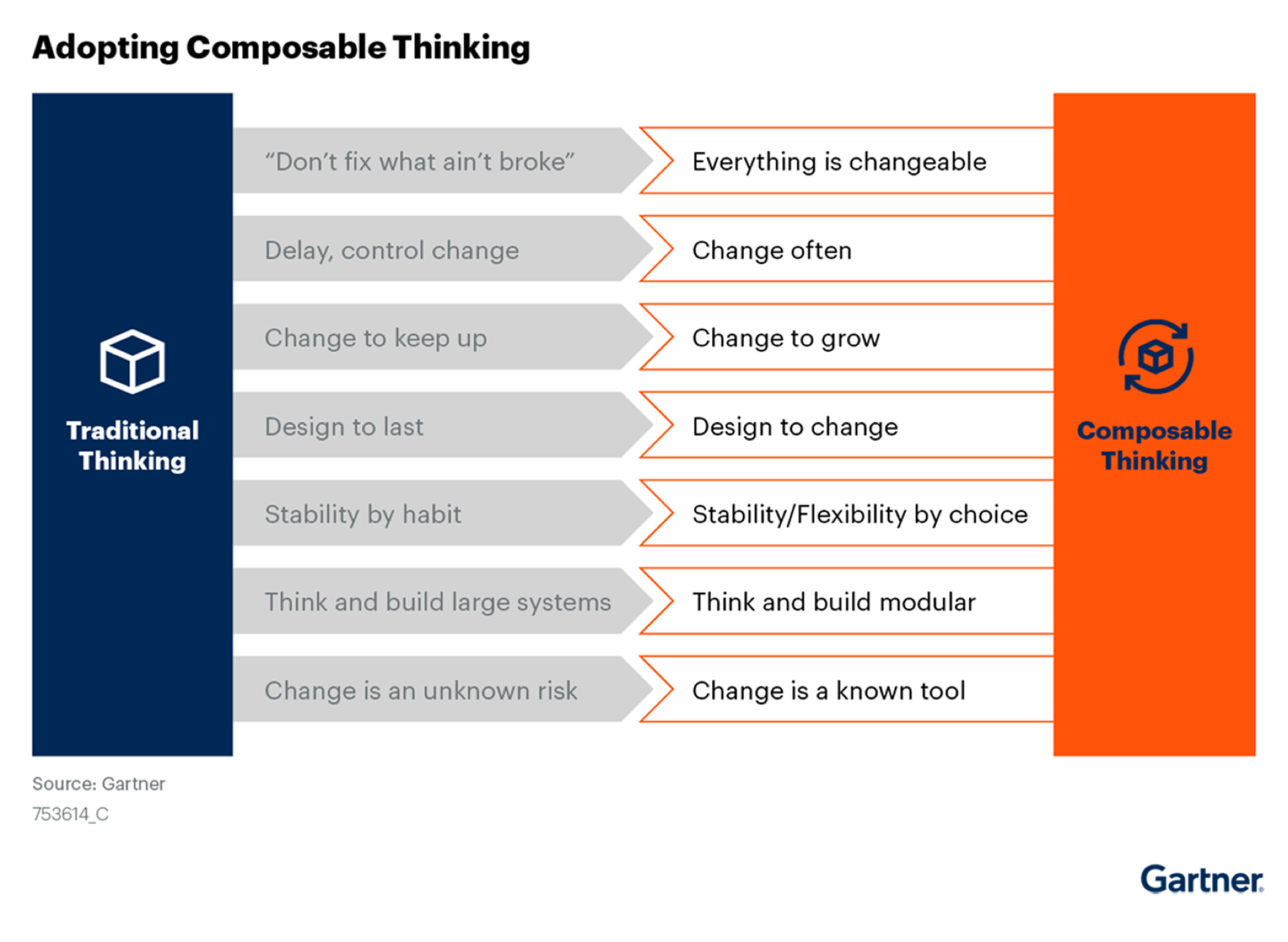In June 2020, Gartner® coined the term composable commerce, boldly predicting that the new approach to building technology systems would drive the future of business. A little over one year later, the technological research and consulting firm released “Becoming Composable: A Gartner Trend Insight Report.” This report stressed the importance of being prepared for change, presenting composability as a key enabler of change and laying out details to help guide organizations through the process of becoming composable.

As the report summary explained, “Incorporating composability into digital business enables the enterprise or public agency to change and grow despite persistent uncertainty. Instead of avoiding the risk of change, executive leaders must reinvent their thinking to see change as a well-trusted tool for business resilience and growth.”
With more and more brands starting to embrace composable commerce, Gartner refreshed and re-released the report in January 2023. And, as part of our new Thought Leadership Program, commercetools chose to provide readers complimentary access to it.
For brands that rely on digital commerce to drive revenue and business growth, composability is a relevant strategy worth exploring. At its core, the approach is designed to give leaders the flexibility and agility needed to create and deliver experiences that both meet the needs of the business as well as customer expectations. In the past, the limitations of legacy platforms made it difficult and risky for a brand to adapt its technology to address new channels, consumer trends and market shifts. Today, however, composable commerce leverages MACH® architecture to provide a plug-and-play environment that supports innovation and experimentation.
In its report, Gartner presented two key predictions:
By 2024, 20% of Global 2,000 CEOs will report an increased appetite for risk and improved resilience, both attributed to modular business redesign.
By 2024, the mantra for new SaaS will be “composable API-first and API-only,” relegating traditional SaaS vendors as “legacy.”
We believe these predictions are already being realized by brands that have migrated to the commercetools Composable Commerce solution. Regardless of business model, B2C, B2B, D2C or a combination of all three, our customers are discovering composable commerce allows them to turn vision into reality without fear.
The ability to not just slightly adjust the direction but completely change the direction…is a critical part of our business. That’s why we embraced the approach of composable architecture — one day we don’t know we want a referral program, [and] the next day our marketing team wants it. If we can just plug it in easily, obviously that’s a big win. That was and still is the philosophy behind the business.
Chief Technology Officer, Scentbird
Composable commerce and MACH architecture really allows us to be flexible [and] enables speed to implement where needed and where required [in accordance with] any local regulations or legal requirements.
Head of Engineering, International, Alcon
The whole concept of commercetools started with microservices, API, headless architecture. This architecture solves our first, immediate problem — that is migrating this 20-year-old monolithic platform. German engineering prowess is indisputable — the dedication given to the quality, the stability, resilience and skill, it’s unmatchable.
Director of Technology, Nuts.com
One of the first things customers discover when they begin the migration process is that it's often necessary to realign their team structure to capitalize on the newfound flexibility composable commerce delivers. Instead of horizontal teams that focus on specific technology areas (like database, infrastructure, backend, frontend, etc.), teams need to be set up vertically to include experts in each area. As Andreas Rudl, VP of Global Marketing at commercetools explained, horizontal teams are not effective in a composable commerce environment. “Smaller vertical teams that focus on business domains (like pricing, checkout, etc.) are able to capitalize on the benefits MACH delivers.”
This is just one example of how organizations need to align their operations, processes and mindset to support composability. Gartner’s report suggests that “The journey to composable business begins with leaders and decision makers embracing a new way of thinking — the seed of cultural change that manifests in a new character of emerging business strategies.”
The graph below, excerpted from the report, illustrates how traditional thinking differs from composable thinking.

Gartner proposes that there are two ways brands can approach embracing composability, pointing out, “A top-down or bottom-up approach can work, depending on the organization’s leadership culture.”
Top-down begins with composable thinking at the executive leadership tier of the organization. Composable thinking promotes creative use of the design principles throughout the organization. Different subordinate segments of the organization apply composable thinking in their own contexts and repeat the top-down approach in their own domain.
Bottom-up begins with applying the design principles of composability to technology within the organization and then promoting the tenets of composable thinking up through the organization in order to accelerate the business effects of the initial technology investments. As technology leaders encourage their business peers toward composable thinking, they begin to apply its principles to business architecture and executive leadership strategies.
Regardless of how the transition happens, when a brand starts to embrace composability, it starts to see “notable improvement in resilience, adaptability and readiness to change.” And, at this point in time, all of these are key to survival in today’s commerce environment.
As Gartner explains it, “A composable business turns strategies, processes, organizational structures and the ways people work from fixed and planned for the long term to flexible and continuously reviewed. The policies are no longer immovable; they are actively updated, replaced or retired. The security and integrity of operations becomes more dexterous as the addressable (and protectable) business capabilities are finer grained to support the composable modularity principles.”

Gartner, Becoming Composable: A Gartner Trend Insight Report, Yefim Natis, Janelle Hill, Partha lyengar, Gene Alvarez, Jennifer Loveland, Chris Howard, Refreshed 12 January 2023, Publish 17 September 2021
GARTNER is a registered trademark and service mark of Gartner, Inc. and/or its affiliates in the U.S. and internationally and is used herein with permission. All rights reserved.